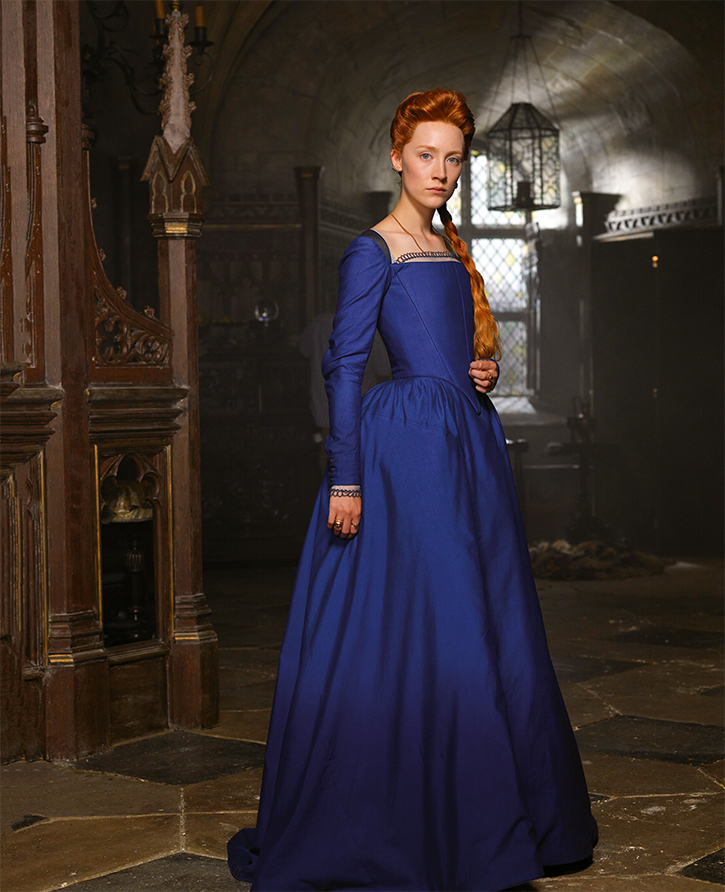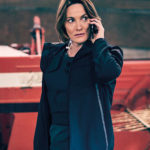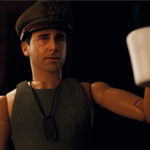
Clash of Queens
DOP John Mathieson explains the digital route of this traditional royal period drama with two impressive female leads.
Words: Julian Mitchell / Pictures: Paramount
We interviewed DOP John Mathieson around the time that the movie The Favourite was released and even though that film and Mary Queen of Scots both come under the banner of ‘period’, they couldn’t be more different. Where The Favourite uses film, unusual angles and lenses and is quite ‘rock’n’roll’ – John’s term – Mary Queen of Scots remains a more traditional piece. John did think it could have ‘rocked’ a bit more. “I wish it was a bigger movie, it needed to be bigger I felt. It’s the trick of British low-budget films that you rely on talent to throw you so far.
“I got a sense of Scotland but just never got a sense of England or how wealthy or different it was; why didn’t Elizabeth have more to draw on than Mary? Elizabeth’s future was pretty uncertain, there were all sorts of people trying to do her in, she was surrounded by hostile countries, it was a very uncomfortable time for her. I wish we’d had more resources to get a sense of the countries; it’s very play-like. The queens never actually met, so that scene was fabricated in the movie. Scotland at the time was a real threat to England, you had the Church of Scotland rising at that time.”

A Bit of Ken Russell?
“I could have been a lot more radical with the lighting or the sets,” Mathieson continues. “If you’re going to go modern with those Elizabethan faces and costumes, I could have recalled The Devils: Derek Jarman art directed it, he was one of the people who got me going. Even now it looks really good; you take something and turn it on its head. Maybe we should have done that more.
“I did come on to the film late, I took over from Seamus McGarvey. So I kind of fell into it a bit and kind of did my thing. I suppose I did traditional things really and of course there’s nothing wrong with that but I didn’t really have time to go through all the options.
“Shooting on film was talked about before I joined and it would look better on film, undoubtedly, but we didn’t have the time or the budget to do it. Ironically I’ve just shot a film on film, and the budget for the stock went down because you shoot less and you shoot less hours; and less hours mean less overtime. Film is more expensive per frame but if your shooting ratio goes down to about an hour a day, even with multi-cameras it generally costs less. With digital I find people shot about two hours or two and a half hours so that means that during that extra hour or hour and a half you can’t lay track, dress the set, fluff things up because the camera’s running. I found runners outside the studios with cold Starbucks because they couldn’t get in and had been waiting for half an hour for the digital camera to stop. If you’ve got ten great takes there’s no point in shooting 30; the candles will burn down, the Irish Wolfhound that was sleeping by the fire will walk off.
“You then have to add that hour to the end of the day which means the editors have to do more work and add crew overtime and that’s your film cost difference gone. So the argument that film is more expensive is absolute nonsense; digital is much more expensive.”

“Shooting on film was talked about but we didn’t have the time or the budget to do it.”

Panavision DXL
Mathieson went with the Panavision DXL large format camera. “It has a large format sensor which was nice. It was great to use this camera with the vintage 65 Sphero lenses, they had a very good feeling and fell off the focus nicely, the backgrounds bloomed with all those candles and mushy background scenes.
“You needed a feel of the time, especially in Scotland where you have a lot of castles with wet dripping walls and skinny little ladies in waiting who are trying to keep away from the walls and as near to the fire as possible. You then have the opulence of Elizabethan England, these big Gothic rooms we found up and down the country in places like Oxford.
Even though there is a scene with both queens in, much of the shooting was of them separately. “We initially shot Margot as she was off to do something else and then started again with Saoirse; they were very much on their own, very independent women and instinctive actresses. They know exactly what they want to do and I was sure to give them as much rehearsal time as possible as unless you’re happy with the rhythm of it there’s no point in shooting. You then have to give them the space to shoot it right. Stagecraft wise I think Margot is precise and is very exacting which is great for us. Saoirse is a bit more loose but I wouldn’t say that her stagecraft is not good, I’m just saying that Margot is more precise.
“She would be asking me questions about where she should be moving when the camera was moving, those kind of questions. Saoirse not so much. It’s incredibly emotional some of it, especially for both of their characters who are incredibly tied up in knots by their respective men-folk. Elizabeth becomes more and more isolated and non-feminine but she came out on top after all that had happened to her, including Mary’s threat.”

How to Make a ‘Big’ Film
John Mathieson talks about how other directors build a ‘big’ movie. “With other directors like Ridley Scott you know where you are. You look at films like Blade Runner; it wasn’t Stanley Kubrick’s squeaky clean world, the world’s going to hell, the environment is screwed, it’s going to be raining and all the rich people are up in the shiny buildings and all the poor people are down in the street.
“Gladiator was the same: it wasn’t historically accurate but you did feel like you were in Rome, you felt how that society worked. He was good at putting you in the right place and giving you enough big shots, not necessarily wide shots, more fixed shots, very layered shots. For the thing about cinema is that you want to be in the world, you don’t want to notice the photography. Roma for instance is a great example: nothing happens. A husband leaves a wife, the maid becomes pregnant and loses the baby, but you want to be in Mexico City by the end of it.
“When you don’t really notice the framing or photography any more as you are in the film, that was my thing with Mary Queen of Scots, I felt that we didn’t quite feel the world around us, to feel the power of England, to feel the uncertainties, to see the power of the church and how militaristic they were. Rome controlled everything and to break from Rome was a big deal.
“You want to feel the agricultural richness of England with billowing fields of wheat, hay wains and overweight cattle with Scotland so barren and cold. It’s not a big film for me, not a big-looking film, I wish it had been. But to be fair it was never really written as such.”

“We didn’t have many sets so it was so great when we were outside as we could move around.”

Moving the Camera
In the movie there are various scenes in the court where the royal procedures of the day meant couriers are sitting and standing while the Queen does the same; this hindered John’s original idea of moving the camera. “If you address the Queen you stand, this was very symmetrical and rigorous. We didn’t have many sets so it was so great when we were outside as we could move around. I would have loved to shoot the streets of London or when she goes to Westminster Cathedral to pray or something, with all that entails. But to get that sense of scale and all those extras wasn’t within our budget and also that would’ve introduced more movement. I’m not saying you should rush around everywhere or start doing handheld for instance but I like movement, I like it when people ‘move through’. A big wide shot collects everyone, collects the feeling of a place, Spielberg and Ridley Scott do that very well. We did move when we wanted to but again you are cutting between the two stories of the two letters the women are writing to each other. So you don’t have an in and an out in a scene, you’re crashing into it, you hear a voiceover and there you are.
“We did overshoot so some things you will lose like your big crane shots, your developing shots and your wide shots; the film overruns and if those scenes are not script relevant and not really doing anything they tend to end up on the floor. That’s a shame so I often try and get people talking in a wide shot with any close-up coverage so they have to use it; as a DOP you learn how to manipulate the shots in this way by getting them talking beforehand or something else that is significant.
“So you try and create the environment, the courts, the palaces. Yes we have some interiors and big places, but I would have liked to have gone through doors into other chambers that led to more chambers and really opened it up – that means you can move. We had a lot more successful movement with Margot than with Saoirse but that was just the way that fell.”

30
The number of hair and make-up artists on the film
1
Number of feature films Director Josie Rourke has directed

Locations
John was happy with the number of lights he had but thought some bigger locations would have helped. “DOPs are always going to say that but these two women made countries go to war over them, so how big do you want to go? David Lean? Yes, Please! But the film didn’t have that lilt on it, it wasn’t that way. But we did blast those small castle windows like hell. Shooting digitally, you have to always be aware of where the sun is, you don’t want any clipping so you have to build out from the ‘burn out’ really. So I did let the windows burn but I didn’t want to use green screen outside because of the risk of fizzy, out-of-focus burnt-out green screen in the background. A lot of the windows were very small and narrow and you get people with hair walking in front of them; this camera was also such a large format that the focus was quite narrow so the background goes out of focus quite quickly. Also a lot of these windows have the leaded diamond cut panes, so when that goes out of focus the keys fizz like hell.
“Luckily I had great scenic painters and I think it’s amazing what they do, they were painting Scottish landscapes and Caledonian forests. Using those meant I didn’t have to worry about keying the green screen, I could let exteriors burn. It also saves a ton of money on CG. You make sure you have heavy skies on these backgrounds, then I can control how much light comes through by lighting the background and piercing into the rooms with Molebeams, which are very much old-style movie search lights. So you get a strong shaft of light, you put a bit of smoke in which of course makes the beam stand out but we’re not trying to make the room too smoky.
“You then have the fire light, a lot of old style space lights in the ceiling. These are not the modern LED style, but with a little bit of blue on to make the castle seem slightly damp, green and wet. Also Maxi lights which are old rock ’n’ roll lights which were aircraft landing lights from the second world war. The lighting was very traditional, nothing too outrageous but then again it’s a period film so didn’t really need the modern ‘fancy’ LED lights. But also I find them quite abrupt and hard on faces even though some of them were soft. The light is very specular and travels in very straight lines and you’re forever softening it. I find tungsten just wraps around people more and it’s softer and kinder; we had some very good looking girls and boys in this film and so it was nice to make them look great.”
 Saoirse Ronan as Mary Queen of Scots and Jack Lowden as Lord Darnley.
Saoirse Ronan as Mary Queen of Scots and Jack Lowden as Lord Darnley.
“Ensby worked with the filmmakers to fine-tune subtle differences between the feel of the two countries.”
Digital Finishing
The filmmakers of Focus Features’ Mary Queen of Scots strove to bring a fresh kind of look to the period drama. Its story, the bloody rivalry between Queen Elizabeth I and Mary Stuart, has been filmed before but director Josie Rourke and cinematographer John Mathieson BSC set out to steer it away from a more staid approach associated with old-school television and to be more contemporary and cinematic.
Colourist Paul Ensby of Company 3, London describes Mathieson’s use of wider lenses and longer takes than audiences might expect and a significant amount of atmosphere, captured in-camera with smoke on set, that he feels help give this telling of the historical drama a unique feel.
“John doesn’t particularly like what you think of as a ‘clean’ image,” says Ensby of frequent collaborator, Mathieson. “He used more low lighting, especially for interiors, to help create a realistic feel, and the smoke just helps in the same way. It can be a bit tricky in the grade to maintain consistency with the smoke and atmosphere but all that really helps evoke the mood of the times.”
The film was shot in some beautiful exteriors and inside large, stately homes in Scotland and in England and Ensby worked with the filmmakers to fine-tune subtle differences between the feel of these two countries. “England was more opulent and warmer,” he explains, “while Scotland was a bit colder. This is reflected in the colour palette of the sets and costumes and we just gave it a bit more of a push in post. Mary is exiled in Scotland and the viewer is meant to feel that Elizabeth’s England is a nicer, more hospitable, place and her cousin inhabits a world that’s colder and darker.”
Costumes were obviously a very important aspect of the look and very slight changes in lighting could have a significant effect on a garment’s appearance. Director Rourke was very specific about costumes, which would sometimes look quite different on screen than they did on the set. So they did a costume pass, in which Ensby would pull keys to isolate areas and very subtly tweak them. “Depending on the kind of light on it,” Ensby says, “it looks massively different. John sourced the material and brought it into the colour grading theatre so we had it right there in front of us.”
Ensby has a strong appreciation for Mathieson’s aesthetic and the two share a fondness for the look of celluloid, even though much of their work has been entirely digital. Mary was shot on Panavision’s new DXL digital camera and Ensby and Mathieson created a film emulation LUT to infuse the images with filmic attributes. He used the LUT as a starting point in the final grade and also added some digital grain via DaVinci Resolve’s Open FX toolset. “It’s very subtle,” he says of the grain he layered in, “but it’s there.”
Ensby is not averse to using his Resolve toolset to build elaborate looks but as a rule, he generally likes to start out with the most straightforward approach of using the “printer light” function, especially when working with a cinematographer with Mathieson’s aesthetic. Ensby suggests his years in the lab as a photochemical timer inform these instincts.
“I don’t use lift, gamma and gain tools extensively,” he says, “and certainly not at first. I want to keep true to what was in the camera for a first pass so the cinematographer doesn’t lose the ‘plot’
of what he’s shot. If it came out of a camera, I want to k now what was in the camera and what was the intention before we start to work with all the bells and whistles that
are available.
“I teach people starting out to simplify the work. They might spend ten minutes working on an image first thing. It’s easy to lose your way. Your eye is constantly adjusting to what’s on the screen. It’s daft to try to just impose a style. You may have 1000 buttons in front of you that can affect the image but if you can make it work as intended with five of them, that’s an approach John and I enjoy.”









